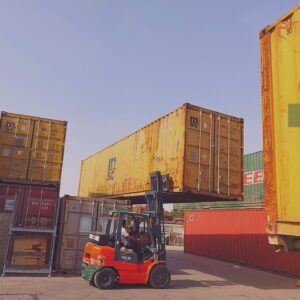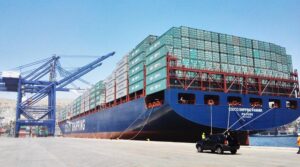
Cross stuffing is a sea transportation method in which the cargo is unload and reload in an intermediary country before reaching the destination and sent to the destination by the intermediary country. This method is used in countries under economic sanctions, although its cost is relatively higher due to unloading and reloading. Next, we will examine the advantages, disadvantages, applications and cost of cross-staffing.
Cross-staffing explanation is like countries that are subject to economic sanctions or do not participate in global free trade, or there is no shipping line between the country of origin and destination, cross-stuffing is a common method of moving goods. Cross-stuffing is a method of sea transportation in which the cargo is transported inside the ship’s containers to the intermediate port. Iran’s cross-staffing is mostly done in Jebel Ali port of the Emirates, in such a way that the containers of the primary ship are unloaded in the port of the Emirates and loaded into the containers of the secondary ship and sent to Iran with a new bill of lading. Unloading and reloading makes cross-staffing cost higher than other methods.
The general process of cross-stuffing cost involves unloading cargo from the original containers and reloading them into new containers. To perform cross-staffing at the port, you need bill of lading, invoice and necessary permits. Documents must be issued in the name of a company in the UAE. After the ship arrives at the port and reloads, a new bill of lading is issued by the Emirati company so that the ship can move to its destination.

The steps of cross-staffing are:
Delivery of the shipping bill to the container maintenance department
Submitting the list of container deposits to the operations department
Registration of incoming containers and unloading of cargo from the primary container and Reloading cargo into new container
Checking the cargo and carrying out inspections by the representative of the goods owner and Registration of documents and acceptance
Placing the container in the ship’s cargo list and Delivery of the container to Kashi and receipt with seal
The cost of cross-stuffing is not specific to the container and shipment and depends on various factors. For example the nature of the goods, special equipment for unloading and reloading, labor and necessary permits.
As we said, the ship carrying the cargo stops in the intermediary country to unload its cargo and put it on another ship. This increases the cost of cross-staffing. The overall cost of this sea transportation method is equal to the cost of transporting the container from the origin to the intermediate port, unloading and reloading, and the cost of transporting the container from the intermediate port to the destination.
Despite the high cost of cross-staffing, this method is the only way for sea transportation. These conditions include:
Economic sanctions: Cross-staffing is used for countries under international sanctions.
Limitation of world trade: If the country has not entered the world trade, it has to receive the goods through an intermediary.
Lack of shipping line: If the country of origin does not have a shipping line with the country of destination, the goods must be sent to the intermediate country.

Among the downs of cross-staffing, we can mention the following:
The cost of cross-staffing is relatively high and In cross-staffing, cargo ships may seize, which will result in financial losses.
Appropriate equipment for unload and transferring cargo must be available and Weather conditions may make it difficult or impossible to transport cargo. Failure to observe steps during unload and reload may damage the cargo.
The important advantage of cross-staffing is that countries can export or import goods despite the presence of objects and limits on trade or in the absence of loading lines. Also, the cross-staffing process does not need to stored, and the cost of storing the cargo becomes zero, and the goods are deliver to the final part faster. These advantages make the cost of cross-staffing seem reasonable.
By using cross-staffing, it is possible to transfer goods to more countries. Countries that cannot have free trade due to specific reasons. Sanctions or the lack of shipping lines, can carry out their business plans using cross-staffing.
However, For Iran, which is under severe sanctions, cross-staffing is an important and good way to transport goods.
In this article, we discussed the cost of cross-staffing, its advantages, downs and application. Additionally, In cross-staffing, the identity of the country sending the goods changes with the change of cargo and ship. Although the cost of cross-staffing is higher than other methods, it is the only possible method to bypass sanctions. The higher cost of cross-staffing is because the cargo is unload and reload and sent in the average country.
Finally, Navban Darya Lian is an expert company in the field of logistics and cooperates with various sea loads. This company provides advice and support to its customers in all stages of sea transportation. Customers can be sure of the safe arrival of their cargo. If you need more information and advice in the field of logistics and sea transportation, contact the experts of this company.